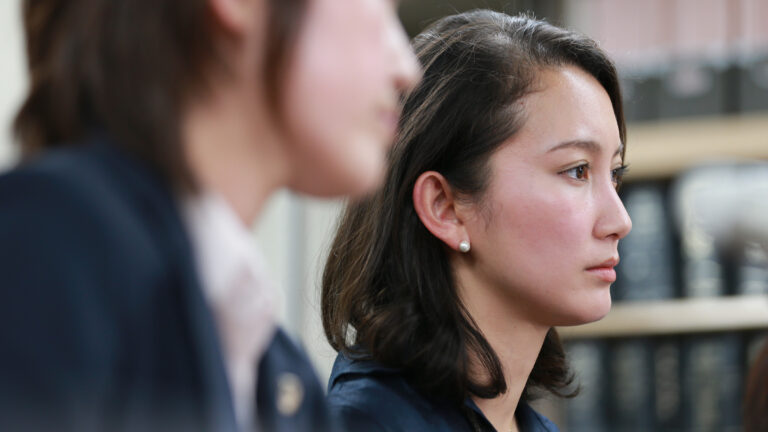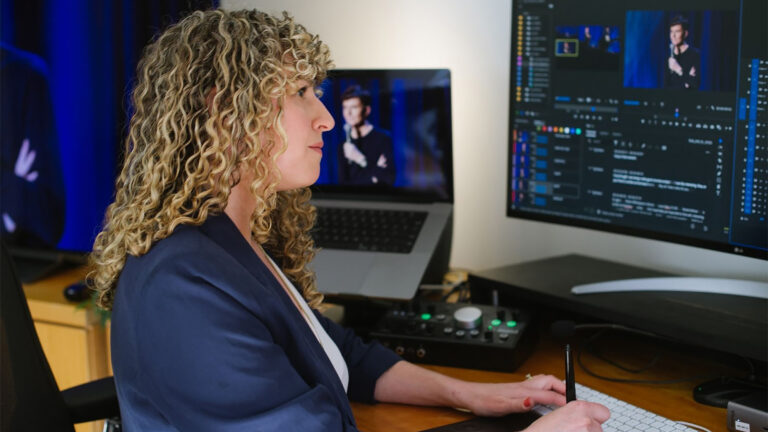Mr. and Mrs. Smith editor Greg O’Bryant was not just joining the biggest project of his career with this new Amazon series, he would also be the “new guy” on a well-oiled machine of storytellers from the TV series Atlanta. Taking the chance paid off for Greg. Not only did he get to try his hand at action, but he got to have his name in the credits twice (Greg also co-produced)!
Plot summary for Mr. and Mrs. Smith
Turning the premise of the 2005 feature film inside out, here John and Jane are two strangers-turned-partners who carry out their spy-like duties under the cover of being married software engineers. Taking their orders from an unseen task master they call “Hihi”, the two learn the ropes of being “Smiths” while learning to love, and somewhat trust, one another.
In our discussion with Mr. and Mrs. Smith editor, Greg O’Bryant, we talk about:
- Using score as your “tonal buoy”
- Turning the tables on the 2005 film of the same name
- Making a relationship sandwich
- Film as a director’s medium, TV as a writer’s medium
- Where a grumpy PA can influence the work
Listen while you read…
Editing Mr. and Mrs. Smith
Matt Feury: Greg, for those wondering, how is this series different or similar to the feature film from 2005?
Greg O’Bryant: Great question, because it is not very similar. Technically, it exists in the same cinematic universe, which there are some hints about in episode four. But it was everyone’s intention to tell a different story with a different tone.
One of the things that Francesca Sloane, the showrunner, talked about was the ‘storytelling sandwich’. That means the characters’ relationship is the bread and the spy stuff is the meat of the sandwich. It’s there, but the ratio should be skewed towards the relationship parts.
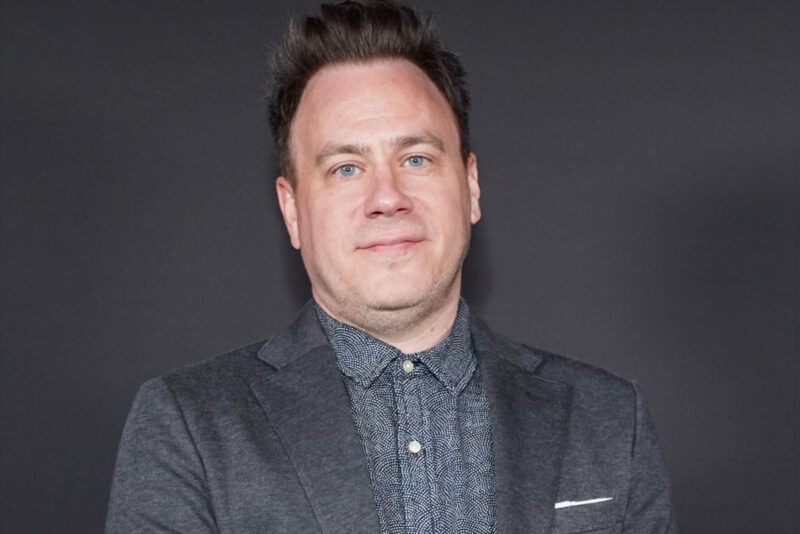
We wanted to tell a story about modern relationships, why we get into them, and why we stay in them. If you think about it, the whole setup of this is a bit like online dating. You show up and meet somebody and you see how far it goes. Sometimes it goes on for a while and sometimes it stops short, but it’s always for totally different reasons. John and Jane had a pretty dire and immediate reason to stay together, but I think it was more about the heart than it was about action. Hopefully we achieved both.
If you look at the ratio of action to romance in the show, the action tends to come in bursts. It’s a slow burn and then there are bursts of action. I think that allowed us to get into the action and really spend time on it and get it right. The rest of it is a lot of talking, but Donald Glover and Maya Erskine have great chemistry.
MF: They certainly do. If memory serves, the last time we spoke was for the Apple TV+ series Extrapolations, which you did with your frequent collaborator Scott Z. Burns. I didn’t notice any clear connections between Mr. or Mrs. Smith and anyone from your past. That begs the question, how did you get to be editor and co-producer on this series?
Greg O’Bryant: Kyle Reiter and Isaac Hagy were editors on Atlanta and they are both great editors and great dudes. They work a lot with Hiro Murai, who directed most of Atlanta and the first two episodes of this show.
Kyle and I were friends socially, and he sent me a text one night saying, “Hey, I think this Mr. Mrs. Smith remake is cooking with Donald Glover and Hiro and the Atlanta guys. Would you want to work on it?” And I said, “Yeah, of course!” Come to find out, they had shot Atlanta season four, but they hadn’t edited any of it. And Hiro was committed to directing the first two episodes of Mr. and Mrs. Smith before they could get into editorial on Atlanta.
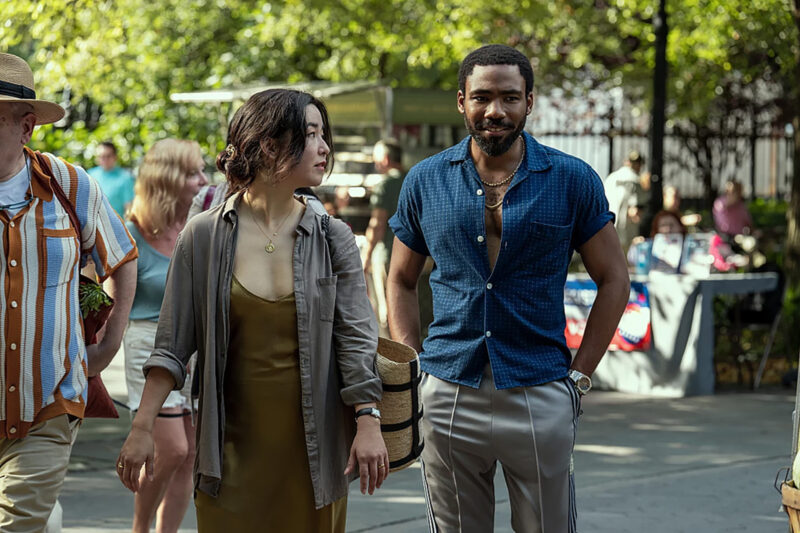
So, they had to get the first two episodes in the can and then go away for a few months. They asked me to come in and do what I did for Extrapolations and Brand New Cherry Flavor, which is producing and editing. I met with Kaitlin Waldron, who is the post producer for the show. She also did Atlanta, Baskets, and a bunch of other great shows. She and I got along well, so we ran Mr. and Mrs. Smith in the background while they were off doing Atlanta.
Hiro, Kyle, and Isaac, with their assistants Kim and Jon, did episodes one and two of Mr. and Mrs. Smith. We kind of treated it like a pilot. It was happening off to the side, and I was working on the other six episodes. As we finished, we all sort of dovetailed it together and mixed and matched on some of the episodes a bit.

MF: I think I asked you this last time, but it’s worth revisiting. The co-producer credit. How is that role important in an editor’s career? What exactly does it entail? What does it do for you?
Greg O’Bryant: I don’t know if it does much. It’s kind of a bespoke thing. I tell everybody that I know just enough to be dangerous. I’m going to weigh in on everything no matter what. I think it’s helpful to have an editor’s perspective on everything, whether it’s reshoots, color, sounds, visual effects, or music.
It’s helpful to have an editor’s perspective on everything.
It’s different on a film. Film is a director’s medium. TV is a writer’s medium. Writers usually appreciate having a technical head in the game. A lot of writers don’t come from a production background. I do, and I think that gives them another perspective when they’re trying to figure out something like, “Which song is better for this scene?” Someone who has both a technical and storytelling background can say, “Well, this song is good, but it peaks out a little bit here. It’s not going to sound right when they mix it. Maybe this other one would be better.”
The producing thing just means everything comes through my room before it’s finished. On Mr. or Mrs. Smith, I was heavily involved in creating the score with Francesca, David Fleming, and Donald Glover. I was also involved with approving the VFX and getting all the sound work done, working with Harbor Sound.
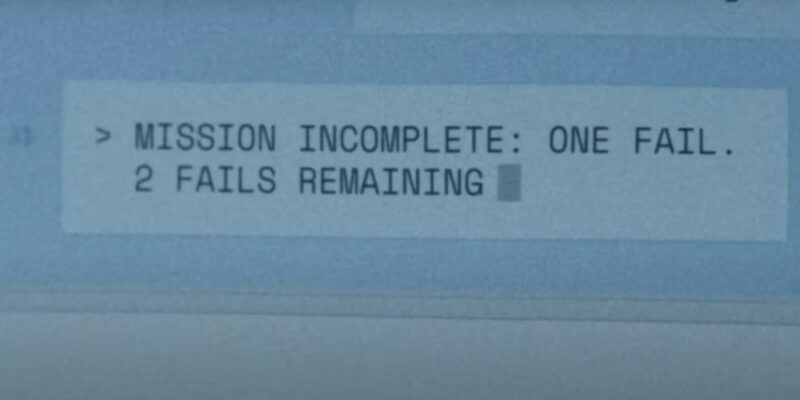
The idea is, once we start editing, everything comes through my room before it’s done, whether it’s another editor’s cut, a VFX shot, a music cue, or a score cue. Whatever it is, it has to go through me. What makes TV special is when it feels like it’s all done by the same hand. I think running it all through my room is great because, no matter who’s in my room, they can weigh in.
It’s not just me. Francesca might be in my room. The other editors might be in my room. But it’s all going to come through the same tiny pipeline and, hopefully, that adds a level of consistency to it all.
MF: What was it like interviewing with Francesca?
Greg O’Bryant: I interviewed with Hiro and Francesca. I talked to Hiro twice before I talked to Francesca. They wanted to make sure that I was going to fit in on their team. These are pretty much all of the people that made Atlanta. Francesca wrote for Atlanta. Donald was Atlanta. Hiro directed it. Kyle and Isaac edited it. Their assistants worked on it. Kaitlin Waldron, the post producer, worked on it. So I was coming into a pretty well-oiled machine.
I think a lot of it came down to taste. They asked me things like, “What do you like? What kind of music would you put in?” They were trying to suss out whether or not I was going to fit in with them. It was like a personality test. These guys are big on vibes.
The interview was easier than the working part. I came into this machine and set up everything to run through my room. I think it took an extra beat sometimes for Francesca to not go to Kyle and Isaac instead of me. When it came down to making a decision, I think her first instinct, obviously, was to go to the people that she’d gone to before. It was on me to be patient. This is a group of really, really smart people. Whoever had the right answer was always the winner. We all just wanted to make it great.
MF: What were the production and post-production timelines like? How long were those phases of the show?
Greg O’Bryant: I came on the day after they wrapped production on episode two and I was on for eighteen months. All of that wasn’t the edit. I think we were in editorial for about a year.

There was some pretty extensive shooting that happened later, which I think is always helpful. I know the larger world tends to think, “Oh, reshooting? Something must have gone wrong” and I don’t think that anymore. I think it almost always helps to go in and pick up a couple of shots for this or that episode, or even add in scenes.
We redid whole scenes for the Mr. and Mrs. Smith pilot. They reshot two scenes entirely in the same location and everything. The team looked at what we had and said, “Hey, we’ve learned some things about this show. Let’s go back and do it a little differently.”
I would say about a year of the show was almost strictly editorial. Then the last six months were for sound. We spent a lot of time on the sound, music, and visual effects. Believe it or not, this is a pretty big visual effects show. There are lots of visual effects.
Believe it or not, this is a pretty big visual effects show
MF: This show is set primarily in New York. For an L.A.-based editor, it seems like you’re always working in New York City. Where were you cutting this?
Greg O’Bryant: I tend to be where the crew is. I was in New York while they were there and I stayed there when they went to shoot in Italy. Then we edited in L.A. until we got all the cuts, reshoots, and pickups done. After that, I went back to New York to mix at Harbor.

I’m pretty big on mixing in-person. I’m pretty big on working in-person in general. I don’t know if that’s something that we want to get into. It’s such a hot topic right now. But I’m pretty big on in-person work, and so were all these guys. It was pretty important for all of us to be together.
MF: Do you have any kind of influence? If working in-person is your preference, can you make that happen?
Greg O’Bryant: I don’t know that I’d say I could make it happen. I think the kinds of people that I want to work with naturally gravitate towards that. I like the work. I love people. I think that personalities influence the work. Even if you have a bad apple on the team, they influence the show in some way. That it’s what makes it human and interesting. Even a grumpy Production Assistant can affect the storytelling in a weird, ethereal way. So, I think it’s interesting to be in-person.

The New York thing is all about tax incentives. It’s just cheaper to for me to be there. On this one, I had an assistant in New York, Jacqui Kaplan, who was amazing. I had my L.A. assistant, Steph Perez, who I’ve been working with for a few years now. She was in New York with me for part of it, but not all of it. Jacqui was actually in New York the whole time. We also had Mike LaFond for a little bit in New York. Then Isaac and Kyle had their assistants, Cameron Ross and Jen Bryson too.
MF: There’s another editor, Kate Brokaw.
Greg O’Bryant: Yes! Kate did a ton of work on the show.
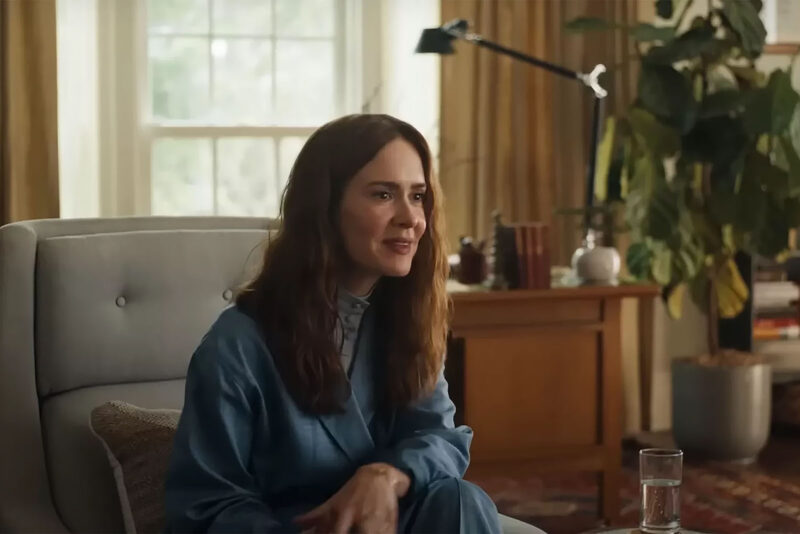
MF: So there were two editors on the first two episodes, three editors on the third, and two editors on the fourth and fifth. Then you carried the ball in the final three. Why was the series so front-loaded with editors?
Greg O’Bryant: You know what’s weird? It’s not always about which episodes need the most help. One cool thing was the way Kaitlin laid out this show. She found a way to make this budget and the schedule work without us turning over cuts while we were filming. We didn’t start showing stuff until after they were done filming and we were all together.
I think that bottlenecked us a little bit when dailies were coming in. Kate was essential to that because I can’t assemble dailies and edit at the same time. She worked a lot on episodes three and four, but I still finished every episode.
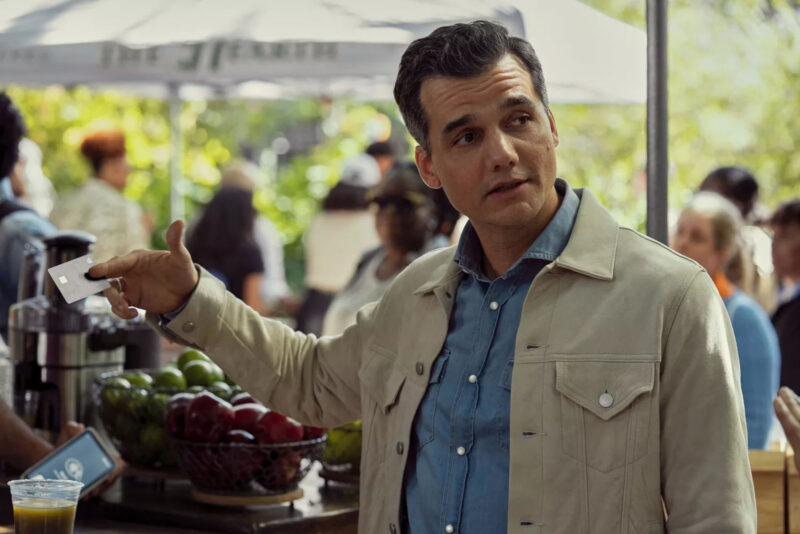
The reason Kyle is on episode three is because they shot that one in Italy. There wasn’t much we could do in the way of reshoots. And as the tone of the show evolved, as we started to learn how to best use Dom and Maya’s chemistry, we found some pieces of it worked and some didn’t. So episode three had to change a lot. Kyle helped out a bunch with that episode, figuring out how to make it work, while I was doing God-knows-what on the other episodes.
Kate did the editor’s cut and the director’s cut for episode three, and I know she did the editor’s cut of episode four. Maybe it didn’t change very much at all until we did the Mexico shoot. The whole thing in Mexico on episode four was shot months and months later.

MF: One of the things that fascinates me the most about this series is the opening. You don’t have an editing credit on the premiere, but as co-producer, everything goes through your cutting room. Tell me about establishing the pilot.
Greg O’Bryant: Interestingly enough, that whole beginning was picked up later. I think we learned from making the show that it needed to hint that that road to nowhere existed. I think it sets the stakes. Once we saw the ending of episode eight, which was Donald’s episode, we felt like the show needed to set up that road to nowhere earlier in the show. I think what Francesca did and the writing of that was brilliant. And, for anybody out there who’s worked with networks, they’re never going to turn down an action set piece beginning with two famous faces. So it worked out for everybody.
MF: I don’t want people listening to think there’s not a lot of action in this, but comparatively speaking, it has a lot of intense, dialog-driven scenes that can go on for five minutes, and then you’ll have a chase. I’ll give you an example.
There’s an episode where Donald and Maya meet another pair of Smiths and have a dinner party with them. It lasts a long time and ends with them saying, “Hey, why don’t you go out and do a mission for us?” because the other Smiths are basically one level up the spy ladder from the Jane and John that we know. You see them jump in a helicopter and go off to the jungle. They’re surrounded by militants. Then it cuts back to them in the chopper looking all bloody.
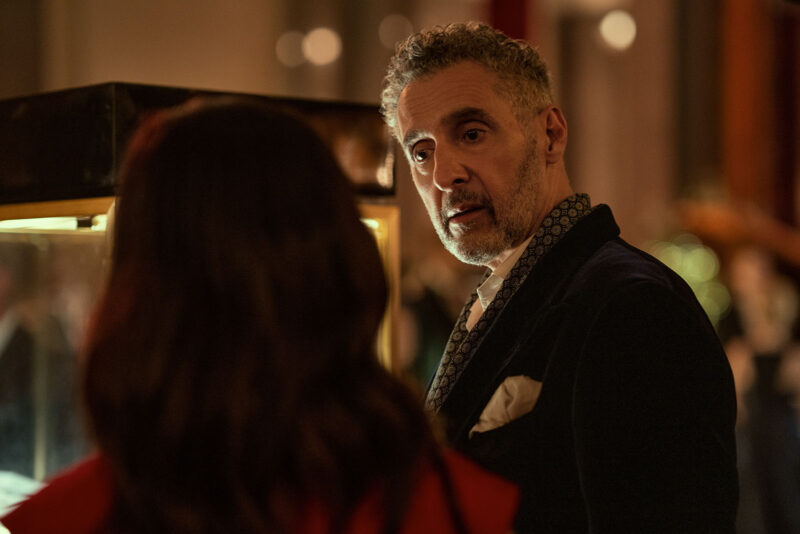
So there’s no action there. It’s all just quick cuts and then the aftermath. This show leans much more into dialog and character than it does action. Was the network always okay with that?
Greg O’Bryant: I wish we could fly Francesca in here to weigh in. She had a lot more interaction with the network than I did. I was hearing everything second-hand. But I’ve never worked with studio or network executives who didn’t want less talk and more action.
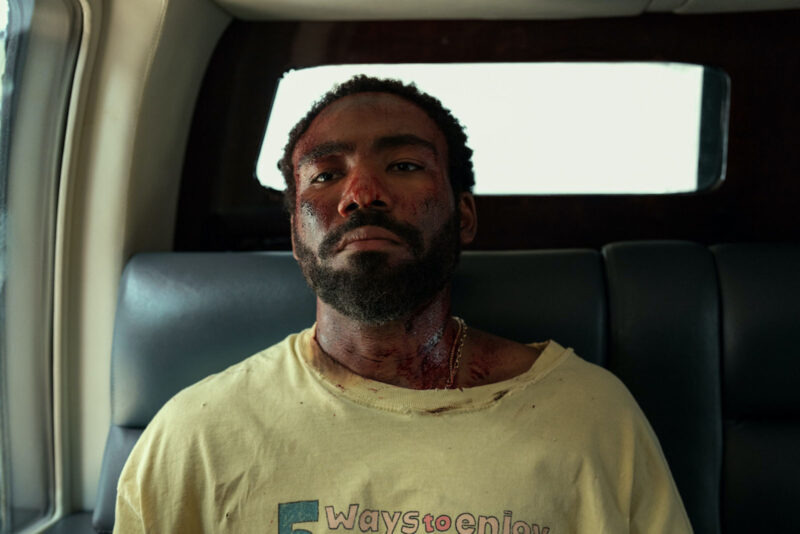
I’ll tell you something interesting. Originally, we edited episode four without anything from Mexico because it was months before we could go down there to shoot. So we all got used to this scene where they take off and then it hard cuts to the Smiths covered in blood. For a while, we thought we weren’t even going to do the Mexico shoot. People were saying, “Maybe we should keep this cut because it’s so funny.”
So, the crew went down to Mexico and they shot a very elaborate sequence. It was much more complicated than what you see in the final cut. But we all knew that sequence was going to have to be better than that funny hard cut. We tried it a bunch of different ways. We spent weeks tweaking just that little sequence. We really beat the bushes before coming up with that fast, vibe-y, out-of-control thing we ended up with. I think we found a good middle ground. But more importantly, that’s the tone of the show. The tone of the show is about how to get that hard cut to be funny. We need to remember that these guys aren’t that good at being spies.
We need to remember that these guys aren’t that good at being spies.
MF: When you do share episodes, how do you divide the work with co-editors and how do you stay in sync once the work begins?
Greg O’Bryant: We don’t work at the same time. In that instance, Kate did the assembly and the director’s cut. She went farther than a director’s cut. Then I took it and did a lot of notes on it, and got it into the network. It got to a point where the other episodes were getting better faster than that one, which also had a much more convoluted plot that we had to simplify. Then I think Kyle took a crack at it. He figured out a couple things that worked. He kind of cracked it. I think I probably finished it from there.
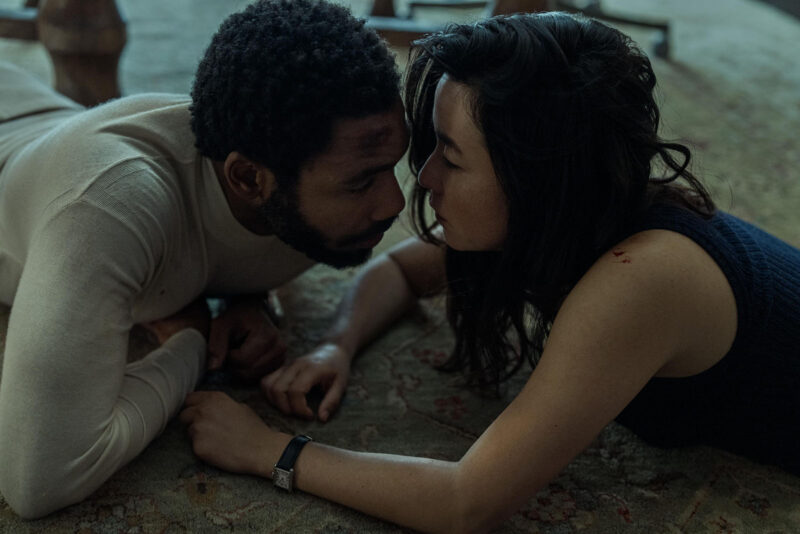
I’ve worked on reality shows where somebody takes one act and somebody else takes another, and then there’s a finishing editor that goes through it. I could not imagine working like that on this show because the tone is hard.
Communication is absolutely the key to this whole thing. That’s why being in person is so valuable to me, because everyone tends to sit down together at lunch, but you end up talking about the episodes. You end up saying things like, “I found something good in episode four” and maybe that triggers whoever’s working on episode six to say, “Hey, I have something like that that I wasn’t going to use. Wouldn’t it be interesting if I put that in?” You start finding the things that get everybody excited. That guides everybody back to their own part of the work to find the things that make it unified.
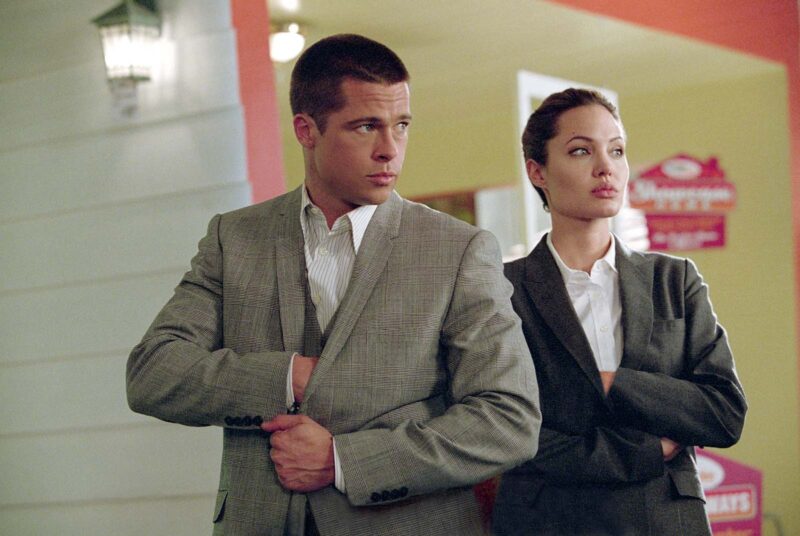
MF: How long does it take to do an episode of Mr. or Mrs. Smith? Is it even possible to sum that up?
Greg O’Bryant: In this case, no. This one was just so weird. There was a period of a few months where I was the only editor. Kyle and Isaac had finished their parts and Kate had gone off to something else. So it was just me, Kate Waldron, and the assistants.
This was more like a feature edit in terms of spending time on the parts that needed time. There are parts of the show that didn’t get touched after everybody got their first say. There are huge chunks of the show that, once the network weighed in for the first time, probably never got touched again. The therapy episode had the least amount of time spent on it, for sure. It was pretty good right away. Episodes one, two, three, and five probably had the most time spent on them.
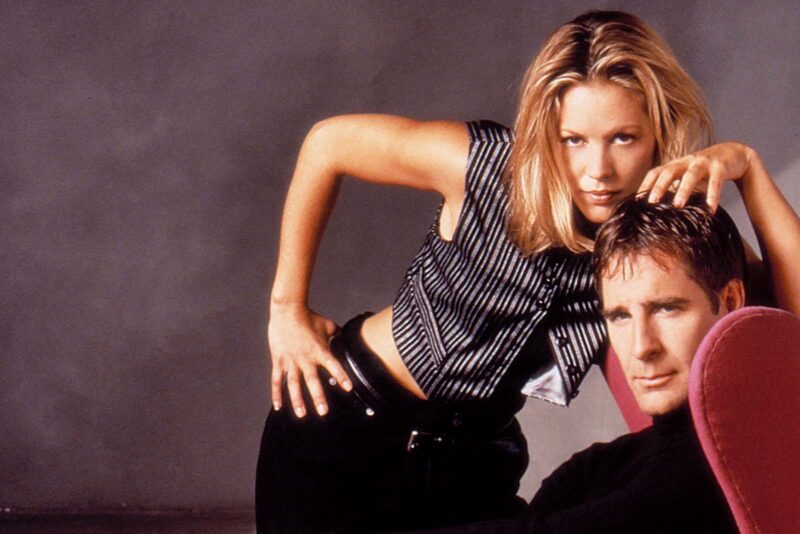
MF: Since you brought up the therapy episode, I did have a question about that. John and Jane are seeing a therapist about their marriage troubles. Within that session, we see vignettes of different missions they’ve been on, and these vignettes are to support the arguments they’re making against each other in the therapy session. So, the whole episode takes place in the home of the therapist, but there are multiple action sequences that you cut away to. Does that kind of structure present any kind of challenge? What are your recollections of working on that episode?
Greg O’Bryant: That episode was so much fun because it’s the one with the most straightforward comedy and it had the most improv. There’s a fair amount of improv in the show. Donald and Maya are both comedians, so there’s a lot, but that one had the most improv.
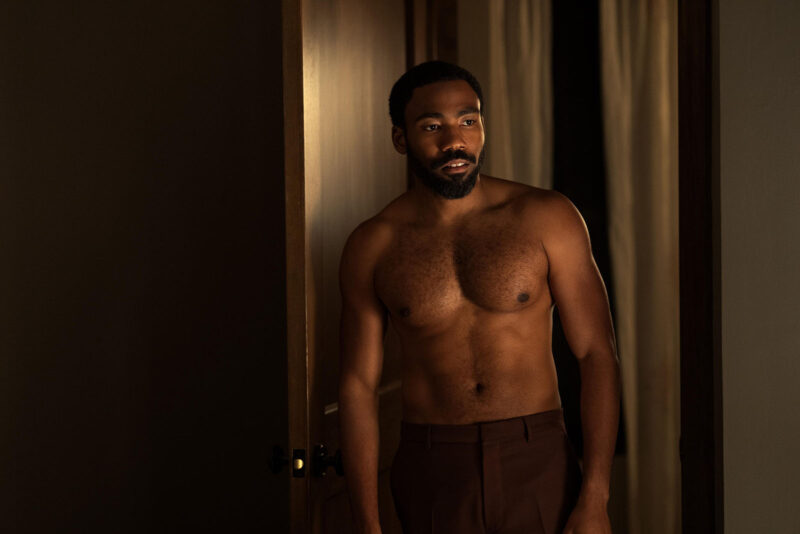
When I’m editing, I always ask if what I’m doing is linear to the character’s subjective experience. That’s the way that episode plays. Even though it’s non-linear, it is very linear to John and Jane’s experience. It’s not as hard as you might think. It would be different if I had to take the story apart and do it in a different order, like Memento. That to me feels like a real brain teaser. I would need an algorithm or a chart on the wall to do it.
The nonlinear part of it felt very linear to us as we made it. But the improv was the most fun part because Donald and Maya are both so funny. And I’ve left out Sarah Paulson, who is amazing. All of the guest stars on the show are amazing. They all brought something fun and really interesting. I think everybody was just excited to work on the show.

MF: Since you brought it up, how do you manage improv in the Avid?
Greg O’Bryant: I love it. I think it brings such good energy to things. It feels more alive and urgent, even a little dangerous. It’s kind of a high-wire act. I come from an improv background, weirdly, because I did so much unscripted. And one of the first movies I ever cut was called The Lie. It was completely improvised.
I welcome improv, but you need to factor in the time for it. You have to watch and catalog all of it. It’s a different process. When I edit regular dailies, I’m pretty fast because I want to get it on its feet and decide what’s working. You can’t do that with improv. Sometimes it’s even hard to keep your camera language. If you want to keep a little improv jag going, sometimes you have to go to a shot that you don’t necessarily want. Luckily, we had the tools to do a little ADR to tie some stuff together. We had the time and the budget to bring the actors in and record.
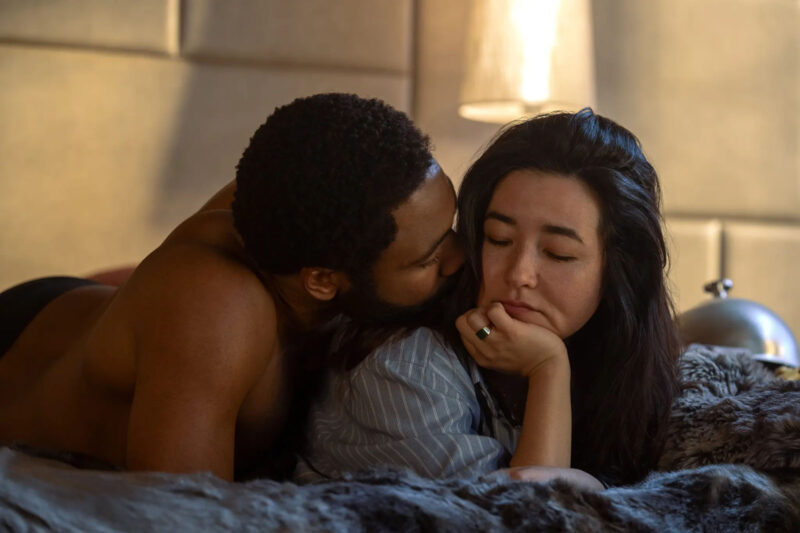
MF: The final episode features an extended cat-and-mouse style chase sequence between Jane and John, and there are dramatic dialogue beats within that sequence. This episode probably has the most even mix of dialog and action. Do the swings between those two types of editing change the way you work?
Greg O’Bryant: They certainly influence each other. I think every editor edits to their taste, whether it’s action or dialog. I edit action scenes a certain way, and I approach dialog scenes a different way. When you have both in the same episode or even in the same moment, I think they influence each other. I just try to make it feel real. How do I make it feel honest?
I just try to make it feel real. How do I make it feel honest?
This is a ridiculous situation. They’re fighting over a gun in the library of a townhouse in New York because they’re owned by a shadowy spy agency. But I have to find the reality and the emotion in those moments, whether it’s dialog or action. I want the action to feel real, but I also want it to feel like they could just start talking. You also don’t want the action to get too brutal where there’s no way that they could stop and talk. That would be ridiculous.
MF: For those that haven’t seen the show, Jane and John get their orders via messages on their phone from an unknown boss they call “Hihi” because that’s how he or she begins all their messages. “Hihi.” So you have your usual screen work, which can really add up. All the phone screens and computer screens. Earlier, you talked about the VFX load being more than you might think. Where was that within the context of the show? Do you take that on or do you leave it to your assistant or your VFX editor?
Greg O’Bryant: All the computer screens are VFX because we rewrote and redesigned all of it. We didn’t even design the spy app until after production. A lot of their house is a set, so there were a lot of VFX set extensions. They used rubber guns sometimes, but mostly they were shooting blanks. We had to redo almost all of it because that’s just what happens. If you want to change it two degrees, you have to take out the squib and put in a different one. There’s a whole lot of VFX in the car chases, sometimes to get the cars closer together, sometimes to make the cars look like they’re going faster.
We did a lot of VFX in the Alps to make the fog and snow consistent. Some snow is real, some is fake. Luckily, our VFX supervisor Eric Pascarelli is amazing. He always had an answer for everything. There were a couple of stunts and backgrounds that had to be touched up. It was all stuff that was invisible. We didn’t want it to feel like we were doing the effects. We wanted to keep it real.

This is how I’m familiar with doing it: I mark up the scenes and then it goes to the VFX editor. The VFX editor takes my markings, logs it, codes it, and then it goes into VFX Land. We didn’t start approving anything until we were all locked. At first, it would be two-hour sessions sitting in Eric’s room looking at a monitor, banging them into shape, approving them, and sending them back with notes. By the end, we had it down to a half-hour Zoom call twice a week. And I’m not just speaking for myself on these calls. I’m also speaking for Francesca. One of the reasons everything runs through my room is so I can learn what the showrunner or director likes. If I’m there and they’re not, I can do what I think they would like.
MF: Mr. and Mrs. Smith has a wry sense of humor played against a love story. Did you pay extra attention to the comedy versus the love story? What about the danger that they’re actually in?
Greg O’Bryant: That’s a really good question. I think any time you’re building a tone, you’re always trying to find that ratio. I never want to say anything is easy because it’s not, but that was one of the easier parts of this show. Donald, Francesca, and everyone else on this show are very funny. It’s like what I was talking about earlier, when I said combinations of personalities come together to affect the show. The Venn diagram of all of our tastes just landed together. I don’t remember ever having a conversation about how much comedy we needed. I think we all wanted it to be real and funny.
One thing that Kaitlin and I talked about was, “How do we make this show feel like a good hang?” Overall, if you’re going to watch the show, you want it to be like a good hang. That’s what we’re leaning into. So I just tried to make it feel like when we hang out at lunch together, all the people that were making the show.

MF: You mentioned that one of the things that you bring to the table is sound work and influence over the music. Tell me about that aspect of the show.
Greg O’Bryant: One of the great joys of working on the show is that I never had to break out my iPod playlists. Donald is literally a musician with great taste and Francesca is a big music lover. We also had Jen Malone, the music supervisor from Atlanta, and Donald’s co-producer, Fam Udeorji. We had a lot of musical minds in the room. We never were at a lack of great choices. All I had to do was weigh in on whether they were good for the story or not, or whether they would hold up technically.
Anyone know what happened here? pic.twitter.com/wdwk9lpyXc
— Blind Mike (@BlindMike_) January 25, 2024
Sometimes they’d come up with this great old song and I’d say, “I don’t know that this recording is going to sound great when we get into the mix.” But I did spend a lot of time with the score, which was hard to figure out. This was probably the hardest score I’ve ever had to figure out. We started with a 1970s feel that wasn’t working. Then we tried some more modern stuff and that wasn’t working either. Mixing them didn’t work. Then we scored the show emotionally, it started to come together. We started to learn a little bit about the show. That was one of the big watershed moments of figuring out the show. We started to learn about the emotional parts of the show and that helped us sell it to Amazon.
Now, surprisingly, that is not at all what the final score of the show is. When we brought on David Fleming, the composer, one of the first things he said was, “This action needs a lot of love.” He figured it out almost immediately. He had a vision for the show right away and he got in there and just did it.
Tyra Banks was stuck between two furries at the Knicks-Nets game in Brooklyn last night. pic.twitter.com/8JzwNIMxn8
— Pop Crave (@PopCrave) January 25, 2024
I think everyone who worked on the show would agree that that score is a tonal buoy. When the score was done, the show finally felt done. We scored the whole show at the end. We didn’t do much while we were cutting. We did temp while we were cutting, but we didn’t do any work with Dave until the show was locked.
MF: Were you able to learn any techniques from any of your co-editors?
Greg O’Bryant: Kyle and Isaac are both cool customers. They don’t grapple, and I think that was something I needed to see. I’m on year ten of my big narrative TV editing journey. I’ve been editing for twenty years, but before that, I was cutting a lot of reality shows and indie films.
@taylorquitara Not your average Thursday night Art show huh?!? @Timothy Goodman #ad ♬ original sound – Taylor Quitara
As far as union shows, I’m in year ten, but it doesn’t feel like it. I think everyone suffers from imposter syndrome. And being brought into a team that’s a well-oiled machine also was flattering. I think Atlanta is one of the best shows ever made, so to be invited on as their producing editor was intimidating! But seeing Kyle, Isaac, and Hiro approach their work with a sense of fun was helpful. I think all editors need to see that it doesn’t have to all be stress and anxiety. Editing should be fun. It should be enjoyable. We should find a way to do it that doesn’t kill us.
I think I lean towards being a bit of an anxious person, a neurotic way. Seeing how calm and cool this team was about the whole thing was inspiring. I’m going to take that with me into future shows, for sure.
Editing should be fun. It should be enjoyable. We should find a way to do it that doesn’t kill us.
MF: What was the most rewarding aspect of doing the series?
Greg O’Bryant: I hadn’t done action before. I’ve been wanting to do it for a while. All editors listening to this probably know that it’s very easy to get pigeonholed. If you’re good at a certain thing then people think that means that you might not be good at other things. I felt pretty good about comedy. I wasn’t worried about that. But the action was my biggest challenge going in. The first time I saw someone flinch at a certain moment in a fight scene I cut was rewarding. I thought, “Good, I can do this too.” Because I didn’t know! I felt pretty good about it. I studied up. But proving to myself I could do it was a big deal.
MF: Greg, I enjoyed all the work that you and the team did on the show. I always enjoy talking to you about the work and I think, given a little time, I may be able to forgive you for leaving me on a cliffhanger.
Greg O’Bryant: I didn’t have a ton of control over that, Matt. But thanks for having me, as always. I always have a great time.



